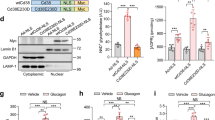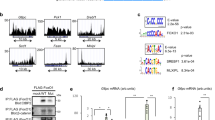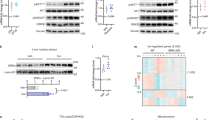Abstract
Hepatic gluconeogenesis is essential for maintenance of normal blood glucose concentrations and is regulated by opposing stimulatory (cyclic adenosine monophosphate, cAMP) and inhibitory (insulin) signaling pathways1. The cAMP signaling pathway leads to phosphorylation of cAMP response element–binding (CREB) protein, resulting in recruitment of the coactivators CREB-binding protein (CBP) and p300 and subsequent activation of gluconeogenesis2,3,4,5. Insulin signaling leads to phosphorylation of CBP at serine 436, a residue near its CREB-interacting domain, but it is unknown whether this event modulates cAMP signaling6. Here, we show in vitro and in 'knock-in' mice that a mutant CBP (S436A) is aberrantly recruited to CREB protein, resulting in inappropriate activation of gluconeogenesis in the fed state and glucose intolerance resulting from increased hepatic glucose production. We propose that insulin signaling may directly regulate many cAMP signaling pathways at the transcriptional level by controlling CBP recruitment.
This is a preview of subscription content, access via your institution
Access options
Subscribe to this journal
Receive 12 print issues and online access
$209.00 per year
only $17.42 per issue
Buy this article
- Purchase on Springer Link
- Instant access to full article PDF
Prices may be subject to local taxes which are calculated during checkout




Similar content being viewed by others
References
Hall, R.K. & Granner, D.K. Insulin regulates expression of metabolic genes through divergent signaling pathways. J. Basic Clin. Physiol. Pharmacol. 10, 119–133 (1999).
Gonzalez, G.A. & Montmimy, M.R. Cyclic AMP stimulates somatostatin gene transcription by phosphorylation of CREB at serine 133. Cell 59, 675–680 (1989).
Chrivia, J.C. et al. Phosphorylated CREB binds specifically to the nuclear protein CBP. Nature 365, 855–859 (1993).
Kwok, R.P.S. et al. Nuclear protein CBP is a coactivator for the transcription factor CREB. Nature 370, 223–229 (1994).
Herzig, S. et al. CREB regulates hepatic gluconeogenesis through the transcriptional coactivator PGC-1. Nature 413, 179–183 (2001).
Zanger, K., Radovick, S. & Wondisford, F.E. CREB binding protein recruitment to the transcription complex requires growth factor-dependent phosphorylation of its GF box. Mol. Cell 7, 551–558 (2001).
Yoon, J.C. et al. Control of hepatic gluconeogenesis through the transcriptional coactivator PGC-1. Nature 413, 131–138 (2001).
Puigserver, P. et al. Insulin-regulated hepatic gluconeogenesis through FOXO1-PGC-1α interaction. Nature 423, 550–555 (2003).
Quinn, P.G. & Granner, D.K. Cyclic AMP-dependent protein kinase regulates transcription of the phosphoenolpyruvate carboxykinase gene but not binding of nuclear factors to the cyclic AMP response element. Mol. Cell. Biol. 10, 3357–3364 (1990).
Liu, J.S., Park, E.A., Gurney, A.L., Roesler, W.J. & Hanson, R.W. Cyclic AMP induction of phosphoenolpyruvate carboxykinase gene transcription is mediated by multiple promoter elements. J. Biol. Chem. 266, 19095–19102 (1991).
Jiang, G. & Zhang, B.B. Glucagon and regulation of glucose metabolism. Am. J. Physiol. Endocrinol. Metab. 284, E671–E678 (2003).
Fisher, S.J. & Kahn, C.R. Insulin signaling is required for insulin's direct and indirect action on hepatic glucose production. J. Clin. Invest. 111, 463–468 (2003).
Bunting, M., Bernstein, K.E., Greer, J.M., Capecchi, M.R. & Thomas, K.R. Targeting genes for self-excision in the germ line. Genes Dev. 13, 1524–1528 (1999).
Kido, Y. et al. Tissue-specific insulin resistance in mice with combined mutations of the insulin receptor, IRS-1 and IRS-2. J. Clin. Invest. 105, 199–205 (2000).
Crosson, S.M., Khan, A., Printen, J., Pessin, J.E. & Saltiel, A.R. PTG gene deletion causes impaired glycogen synthesis and developmental insulin resistance. J. Clin. Invest. 111, 1423–32 (2003).
Greenberg, C.C., Meredith, K.N., Yan, L. & Brady, M.J. Protein targeting to glycogen overexpression results in the specific enhancement of glycogen storage in 3T3-L1 adipocytes. J. Biol. Chem. 278, 30835–30842 (2003).
Tuttle, R.L. et al. Regulation of pancreatic beta-cell growth and survival by the serine/threonine protein kinase Akt1/PKBα. Nat. Med. 7, 1133–1137 (2001).
Roe, M.W., Mertz, R.J., Lancaster, M.E, Worley, J.F. III & Dukes, I.D. Thapsigargin inhibits a glucose-induced decrease of intracellular Ca2+ concentration in mouse islets of Langerhans. Am. J. Physiol. 266, E852–E862 (1994).
Shang, Y., Hu, X., DiRenzo, J., Lazar, M.A. & Brown, M. Cofactor dynamics and sufficiency in estrogen-regulated transcription. Cell 103, 843–852 (2000).
Boileau, P. et al. Decreased glibenclamide uptake in hepatocytes of hepatocyte nuclear factor-1α-deficient mice: a mechanism for hypersensitivity to sulfonylurea therapy in patients with maturity-onset diabetes of the young, type 3 (MODY3). Diabetes 51, S343–348 (2002).
Acknowledgements
We thank J. Lopez, M. Connors, Y. Wang, C. Reardon-Aluis and G. Getz for technical assistance. The human FOXO1 cDNA was a gift from G. Grosveld (St. Jude Children's Research Center) and the mouse Crebbp cDNA from R. Goodman (Oregon Health Science University). This work was supported by a grant from the US National Institutes of Health (R01 DK-63349 to F.E.W.) and The University of Chicago Diabetes Research and Training Center (P60 DK-20595).
Author information
Authors and Affiliations
Corresponding author
Ethics declarations
Competing interests
The authors declare no competing financial interests.
Rights and permissions
About this article
Cite this article
Zhou, X., Shibusawa, N., Naik, K. et al. Insulin regulation of hepatic gluconeogenesis through phosphorylation of CREB-binding protein. Nat Med 10, 633–637 (2004). https://doi.org/10.1038/nm1050
Received:
Accepted:
Published:
Issue Date:
DOI: https://doi.org/10.1038/nm1050
This article is cited by
-
Histone demethylase JMJD1C is phosphorylated by mTOR to activate de novo lipogenesis
Nature Communications (2020)
-
Maternal high fat diet consumption reduces liver alpha7 nicotinic cholinergic receptor expression and impairs insulin signalling in the offspring
Scientific Reports (2020)
-
Emerging role of mutations in epigenetic regulators including MLL2 derived from The Cancer Genome Atlas for cervical cancer
BMC Cancer (2017)
-
GCN5L1 modulates cross-talk between mitochondria and cell signaling to regulate FoxO1 stability and gluconeogenesis
Nature Communications (2017)
-
Adaptive patterns in the p53 protein sequence of the hypoxia- and cancer-tolerant blind mole rat Spalax
BMC Evolutionary Biology (2016)



